Smithson’s Site / Nonsite
January 18, 2009
Smithsons dialectic of Site / Non Site or earthwork / indoor earthworkSmithsons dialectic of Site / Non Site
Site Nonsite
- open limits closed limits
- A series of points An array of matter
- Outer Coordinates Inner Coordinates
- Subtraction Addition
- Indeterminate Certainty Determinate uncertainty
- Scattered Information Contained information
- Reflection Mirror
- Edge Center
- Some Place (physical) No place (abstract)
- Many One
The site is an illogical combination of the senses, where the non-site is a logical picture that is abstract, representing a site.
“Representation” is very important here.
The nonsite is closed limits. This means that it is categorically contained to the field of, say, optics. Within the limits set by Smithson, in his work, Enantiomoprphic chambers, the limits of optics allow Smithson to logically extrapolate the stereoscopic vision to its poles, its ends. Under Smithson’s enantiomorphic optics, the illusionistic space of the fusion (the metting place, the “dinner table”) of the refracted light of the dual globes of the eye, (see diagram) that makes the world one image, is not within the limits of Smithson’s optics. He is doing away with the binocular focul points of the eyes, and therefore is allowed to bring the light to its stereoscopic end through logic. What he is adding is another image of the world… a double image. This is what the extrapolated, categorically contained optical reflective, refractive “bounce light”, symetrical, dual images look like in Smithson’s optics. In Mathematics, it’s called Trisoctahedron symmetry, found in the crystal’s of certain minerals:

“Trisoctahedron or Trigonal Trisoctahedron
The trisoctahedron is a form composed of twenty-four isosceles triangular faces, each of which intersects two of the crystallographic axes at unity and the third axis at some multiple.” – Mining Basics.com http://www.miningbasics.com/html/the_isometric__trisoctahedron_.php
This is my logical picture of what purple light would look like seen through this shape in three-dimensions. There is one light source in the image, which may be called the “flash of the camera”:

Superimposed on top of the crystal is the refracted “bounce light” from the purple “wall” behind the crystal that is ultimately passing through the crystal onto something like a photographic plate, which would be the stereoscopic vision of only purple if it were to be percieved without the binocular focal range of our eyes. (see optics diagram)
Concerning Smithson’s logical limitations on his own optics, imagine an infinite number of points in the visual landscape, like the grand canyon. Then after imagining this, apply this “crystal filter” to every infinite point. What would it look like?
The nonsite consists of Many, categorically contained logical extrapolations that are additive to the site (or earthwork).
More simply put:
The site is subtractive, and the nonsite is additive… or rather:
Site: One whole experience

Nonsite: Many logically contained, extrapolated categories that make up the subtractive experience of the Spiral jetty




… ECT.,
The nonsites converge in the experience of a site, rendering the experience subtractive of the nonsites. For example, stereoscopic vision is an experiential (not logical) impossibility, that must be subtracted in experiencing the site. The mirrors of the nonsites become ambiguious reflections in the site. So, this art (just forget about the categorical containment of “aesthetics”, and whether or not this fits into a category at all) is dialectical, in an inextricable relationship between a site and many nonsites.
Optical Actualities
January 16, 2009
Enantiomorphic Purple light – a suggestion
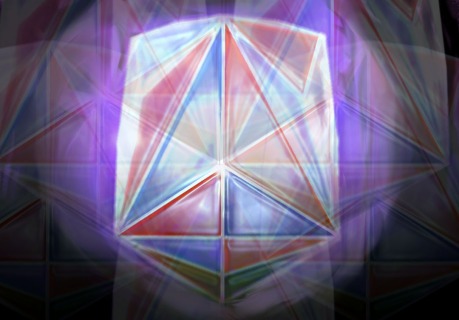
Trisoctahedron crystal symmetry

The three-dimensionality of the Necker cube is an actual three dimensional space, when considering the stereoscopic optics of the eyes. The necker cube and other three dimensional “optical illusions”, are actually three-dimensional. The enantiomorphic (or stereoscopic) vision, is an unresolved tension between disparate dissimilars (like words or lines) that only become three dimensional, when the literary mind is suspended from the stereoscopic vision of the eyes. We can see this, because the abstract lines of the necker cube refer to nothing. They are uncontaminated by “concepts”. It might be said, that they enter the eyes without entering the mind. It only becomes more apparantly three-dimensional, when the content (or the literary mind) no longer has any power over the abstract…
Smithson actually describes his enantiomorphic vision as stereoscopic vision here:
Smithson’s Steoscopic Vision:
“The dual Globes that constitute our eyes are the generators of our sense of the third dimension. Each eyeball contains a retina that functions like a photographic plate inside a spheroid camera. Rays of light penetrate the transparent cornea, the pupil, the crystalline lense and the vitreous body until they reach the end…[The eyes] percieve through a mental artiface of directions without determined distances, which in turn gives the illusion of infinite spaces… The binocular focus of our eyes converges on a single object and gives us the illusion of oneness, so that we tend to forget the actual stereoscopic vision of our eyes or what I will call ‘enantiomorphic vision’ – that is seeing double… In [Enantiomorphic Chambers – a work of Smithsons], the vanishing point is split or the center of convergence is excluded, and the two chambers face each other at oblique angles, which in turn causes a set of three reflections in each of the two obliquely placed mirrors. A symmetrical division into two equal parts is what makes it enantiomorphic; this division also exists in certain crystalline structures” – Smithson, “Pointless Vanishing Points (1967)” (my “enhancements”)
The thing that I find interesting is that the illusion of oneness, is a “binocular convergence on an object”. It is a type of binocular focus, an adjustment of the “vitreous body” to make literal sense out of an actual stereoscopic vision. It is the literal sense of vanishing points, upon convergence of the eyes, that allows us to see the objects as whole, when (for Smithson at least) the objects were “pointless”, arrayed in symetrical reflections in the enantiomorphic chambers of the eyes. In this nonsite, or indoor earthwork by Smithson, the subtraction of the literalness of vision – the act of binocular communion on an object is taken out. What is left, is actual stereoscopic vision. This was, in part, the significance of the crystalline for Smithson.
The coheseive focussed literalness is an interference of the analytical mind, to use my vocabulary, whereas the actual mirrored geometries of enantiomorphic vision are not coheseive. The literal points – the illusory morphology of the landscape – become pointless. This is an enantiomorphic vision, where the mirrored oblique reflections form perfect symetries, where the literal points of reference shatter into an array of matter, with no reference points. Without the literal (analytical) mind, the vanishing points, the communion of objects disintegrates. The object is no longer a whole, but an array of perfectly symetrical refractive and reflective light, like in certain crystal structures. The enantiomorphic vision is “foundational” to Smithson’s aesthetics. It is a way of seeing without the literal mind interfereing. (see above post # 382 on literalness) This is stereoscopic vision – the actual. For every point in the illusory infinite space (an infinite number of literal points), the points, when viewed enantiomorphically (or stereoscopically) disintegrate every point into two. It is an unfeasable image. But the literal mind is feasable as the “fused image” in stereoscopic vision, as James P. C. Southall diagrams in his, Introduction to Phisiological Optics (1961):
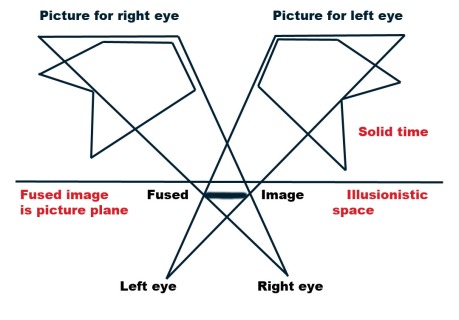
Smithson’s superimposed notes are in red. (I had to reproduce this in photoshop, because the internet didn’t supply the image for me.)
The “illusionistic space” is the fused image, if you consider this diagram. The fused image is the picture plane, or the stereoscopic vision combined. This is an illusion. The note “solid time” is where the images are enantiomorphed into seperate “pictures”. Although, Smithson’s stereoscopic vision differs from this one, in that the literal mind, when suspended from vision, does not result in pictures, but oblique angular refractive, symetrical reflections of light that double the already infinite vanishing points. The fused image of the photographic eye, and the literal mind, make the seen world appear cohesevely as a whole of infinite points, where the enantiomorphic vision allows the world to appear as an infinite number of “double points” making the world no longer appear cohesive at all, but rather ambiguous, and scattered.
So literacy, is an illusory impediment of the mind onto the senses. But, when one looks at things without reading them, without a categorical containment of the mind, it becomes a three-dimensional power struggle because of the disparate dissimilars in the enantiomorphically seen world. So, two dimensions is the illusion, considering that it is a product of the interference of the literary mind with the eyes. And three dimensions is the actual, considering it is percieved when the literal mind is lifted.
Simultaneous Enantiomorphic Looking and Morphological Reading
January 15, 2009
This is my response to Smithson’s essay, “Language to be Looked at and/or Things to be Read”
It might help to put these on when you read Smithson’s essay:
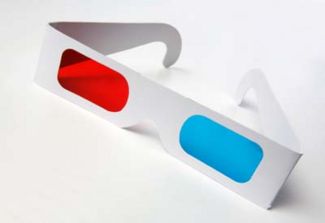
Language operates between literal and metaphorical signification, not meaning. I take this to mean the operability of language, its functioning location (meaning its scale) is somewhere between the literal signs (meaning the symbols are referring to something literal, like “Rock!”) and the metaphorical signs (meaning the symbols, “dead letters” or, “dead sound-waves”, are a first-layer metaphor of something physical, like an egyptian hieroglyph, or a cave painting.) The power of a word is contingent upon context, in the broad sense, meaning the sentence, paragraph, essay, book, room, etc.. The “partially resolved tension of disparates”, meaning, I think, that the power of a word – it’s degree of communicability – is contingent upon the seperated, incompatibility of the context (as defined above), where the word is either muted by this dissolution or insatiated with power. It is the disparates of language, the inseperability and incompatiblity of of words (“concepts”) that creates depth in the language. A literal word, or a metaphor will “pop out” of the otherwise mute background words, because of the incompatibility of the words, or “concepts”. I would ask, how does language have any power at all if the similarities are already resolved? There would be no need to speak. It is, as I described above, an unresolved disimilarity, making the perception (the illusion) of resolved similarities, into an paradox, where at one and the same time, the language is both dissimilar, and illussorily similar. The illusory part is how we understand language. The former, unresolved dissimilarity, is the enantiomorphic talking – the aesthetic perception talking. Congruity, an aesthetic perception of language, not an illusory reading of language, is forced into an incongruent spatial power-play of words. Smithson is both percieving language enantiomorphically as a heap of physical “dead letters” and an illusory reading of language as a morphologically meaningful sieries of “alive letters”. This is why you’re confused about it. Maybe if you read the essay with this paradox of language being both enantiomorphically percieved, and morphologically read at the same time, you may gain some insight on it.
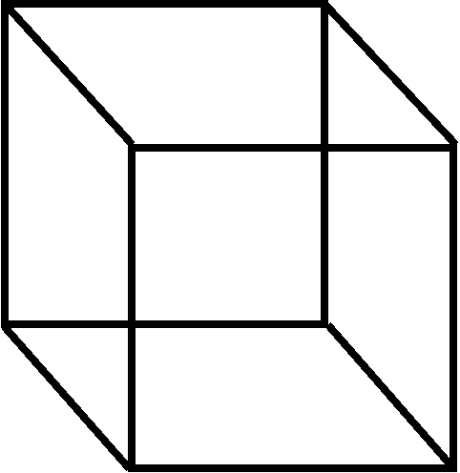
I think it’s interesting how we can map in three dimensions using the xyz coordinate plain, with two-dimensional analytical thought. I attribute this to the scale at which the mind works when calibrated to language. By “scale” here, I mean a “zoom scope” like on a camera that focuses in on a set of problems – this is the scope we “three-dimensionalize” two-dimensional things in. By this, I mean that the scope is focused on two dimensions (i.e. subject / verb agreement … y must = x etc.). This two-dimensional mind follows rules very well. “Do this not this, and then do that, and not that. Upon completion of that, do those, then those, then you will have a three-dimensional cube”. The resulting “three-dimensions” are a product of two-dimensional thought that operates on a different scale. The three-dimensional cube on a page, is then seen as a two-dimensional map with an illusory “three-dimensional” object on it. how one percieves this illusion, is with the eye and ear – that scale – not the analytical, rule following mind. Both make us human, but the former scale is more human, while the latter “lower” scale is more machine… hence the cyborg. We are all cyborgs.
When looking at the cube, it shifts from front to back in three dimensions off of the page. It is the power of the unresolved incongruencies that shove a side either to the front or the back. The tension between the disparate angular lines, and the perpendicular lines causes the cube to move from front to back. Some lines gain more power than others in a constant struggle for power amongst the unresolved disparates. If it were resolved, it would be a set of two-dimensional “dead lines”.
Some Pretty Colors to Look at and some Music to Listen to
January 14, 2009
Climb Back Up the Ladder
January 13, 2009
Stable Two-Dimensional Animated Three-Dimensions
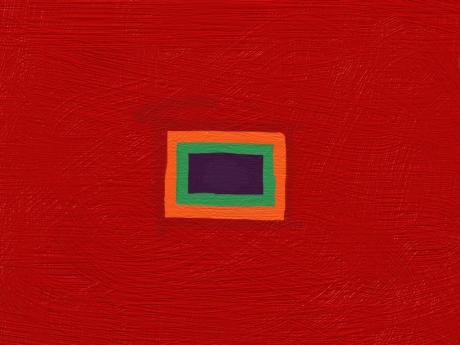
I hope for immediate access to the scale of experience. I think (and I’m not alone on this) we are getting further from experiencing the scale of the eye and the ear, as one “descends”, or “ascends” the ladder of the analytical, technological mind – the two-dimensional mind. Language seems to strengthen the analytical mind that almost pulverizes the eye and ear to a death. This is to say, only, that we are moving away from the experiential scale of the eye and the eear – not to say becoming closer to the “thing-in-itself”. The experience of the enantiomorphic eyes and ears are in an inextricable, paradoxical relationship between the expressive power of the “thing out there”, and the expressive power of the eye and ear (and even the analytical mind for that matter). This makes experience, an inseperably intertwined “loopy” or spirialing paradoxical seizure, or apprehension (not an understanding) of expressive-impressiveness. It is both expressed, and impressed at the same time. The analytical mind rejects these paradoxes of the eye and ear, because it is calibrated to another scale(s). These scales are rendered uni-directionally causal.
The articles “the”, “is”, “has”, as well as present tense nouns like, “runs” “walks” etc… create, I think, a belief in stability, and present moments that could be frozen. This, however, is a result of the technological scale that language operates in. It is not the scale of the eye and ear. It is the scale of the analytical mind. The freezing of moments into two-dimensional pictures of memory, has scaled the mind down to a place where the cybernetic exists – a place far from the senses, that makes us cyborgs. We are human-machine, because of the practical power of the analytical two-dimensional maps. They have nearly destroyed all belief in reality. The project of art and peotry is to bring back a lost belief in reality – a lost scale.

